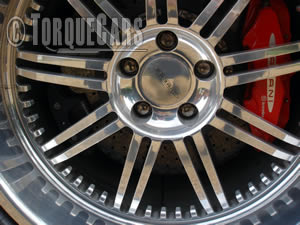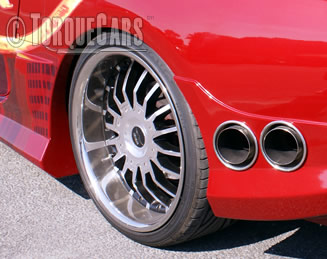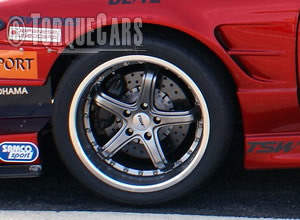Alloy wheels - Styling Your Ride.
"One of the most popular mods is fitting alloy wheels."

Changes to alloy wheels are arguably one of the most popular types of cosmetic modifications that are undertaken nowadays.
Alloy wheels are available in a plethora of sizes, styles, and colour options.
In general, the bigger the wheel and the lower the profile of the tyre, the more attractive it seems.
Please watch my video on Alloy wheels which covers the common problems and pitfalls.
However, there are practical limitations, since huge wheels would have a negative impact on handling and may even scrape against the wheel arches when the vehicle is fully locked.
Take a look at the alloy wheel article in tuning section if you want to learn more or simply get some friendly assistance on the practical side of installing alloy wheels.
Keeping your Alloys looking good
Switching to low-dust brake pads will make cleaning your new rims a much simpler task in the long run.
Be careful with cleaning solutions, as many of these are very acidic and in the long term can cause more harm to the rims than the good. A bit of elbow grease is all that is needed to remove most embedded brake dust, dirt, grime and tarmac.

Addition of an alloy wheel to your automobile just for cosmetic purposes is the sole focus of this page.
Choosing Alloys for your car.
There are varied numbers of nuts on the hubs of different cars, and the distance and size of these nuts also varies. In addition, the amount of internal space in the wheel for braking discs is a consideration.
You will need to know the PCD, offset, and bore dimensions of your standard wheels in order to guarantee that your replacement wheels are within the tolerances of your existing wheels. Choose wisely.
When painted in a dark colour (VIP style), chrome alloy wheels look fantastic, and the fact that most wheels can be painted means that there is an almost limitless variety of conceivable styles.
Spray them with a dark colour to give them a sleeping effect. When alloy wheels are kerbed, they may seem quite unpleasant, thus a broad walled tyre would be an excellent option to help prevent these scratches from occurring. Keep this in mind when selecting an alloy wheel, as some designs are so conspicuous that they almost beg to be kerb-stomped on.
Split rims are made up of two sections that are connected together by a number of bolts. This allows the wheel to fill the arch and a significantly larger tyre to be put on the vehicle.
Please keep in mind that if your wheel is much wider or taller than the typical size, you will need to have your suspension straightened and set up properly, otherwise your handling and safety may be compromised.
Alloy Wheel Designs can be hard to live with.
Complicated wheel designs may make cleaning a tremendous challenge, and brake dust, particularly on rough textured alloy wheels, has a tendency to cause pitting.
More spokes, complex patterns and intricate designs can all be a dirt trap.
Spinners not only offer another degree of difficulty to cleaning, but they also provide a unique visual impact by spinning at a different pace than the rest of the wheel, which creates a fascinating contrast.
Installing Your New Rims
When you have the wheels installed, request that the balancing weights be installed on the inside of the wheels rather than the outside, since they may be rather ugly.
Many alloy wheels provide a better view of the brake disc and callipers, so make sure that they are in excellent shape as well, possibly adding a little calliper paint to help them stand out even more.
The use of spacers within the wheel against the hub will cause the tyres to align with the edge of the arches, resulting in a wider footprint, which will enhance the handling of the vehicle overall.
- Locate your locking nut, and the key for it before you start.
- Note your cars jacking points, a jack should only be fitted to these areas to lift the car.
- Use a chock under the wheel to prevent the car rolling whilst it's being jacked up.
- Release the handbrake (the chocks will keep the car in place).
- Loosen all the nuts slightly a quarter turn maximum with the car on the ground.
- Jack up the wheel so it is raised off the ground.
- Remove the nuts and with two hands and a straight back lift off the wheel.
- Note the orientation of the nuts and line up the holes on the new wheel with them.
- Lift the new wheel into place and put the nuts back on following a top bottom left right pattern.
- Tighten up the nuts but not completely all the way, they should be tighter than finger tight.
- Lower the car to the ground and fully tighten all of the nuts but without breaking them.
- Check all nuts for tightness after 50 miles and 100 miles.
Overall this is a very simple job to carry out and dramatically improves the look and stance of the vehicle.
The performance benefits you get from most alloys are questionable in wet conditions though.
Please Check out my YouTube channel, we're regularly adding new content...
PLEASE HELP: I NEED YOUR DONATIONS TO COVER THE COSTS OF RUNNING THIS SITE AND KEEP IT RUNNING. I do not charge you to access this website and it saves most TorqueCars readers $100's each year - but we are NON PROFIT and not even covering our costs. To keep us running PLEASE Donate here
If you liked this page please share it with your friends, drop a link to it in your favourite forum or use the bookmarking options to save it to your social media profile.
Feedback - What do You Think?
Please use our forums if you wish to ask a tuning question, and please note we do not sell parts or services, we are just an online magazine.
Help us improve, leave a suggestion or tip
Please watch this video and subscribe to my YouTube channel.

 Click to accept YouTube Cookies & Play.
Click to accept YouTube Cookies & Play.